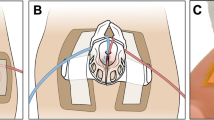Abstract
Neonatal chylothorax (NCTx) and central lymphatic flow disorder (CLFD) are historically challenging neonatal disorders with high morbidity and mortality.
Methods
We conducted a retrospective study of 35 neonates with pulmonary lymphatic abnormalities at our institution who underwent lymphatic evaluation between December 2015 and September 2018. Patients with only pulmonary lymphatic perfusion syndrome were classified as NCTx and those with multiple flow abnormalities were classified as CLFD. Demographics, clinical characteristics, and outcomes were compared using t-tests/Wilcoxon rank sum tests and Fisher’s exact tests.
Results
All 35 patients had intranodal MR lymphangiography and 14 (40%) also had conventional fluoroscopic lymphangiography. Fifteen (42.8%) patients were diagnosed with NCTx and 20 (57.1%) were diagnosed with CLFD. Thirty-four (97.1%) patients had pleural effusions. None of the NCTx group had ascites, anasarca, or dermal backflow compared to 17 (85%) (p < 0.001), 8 (42.1%) (p: 0.004), and 20 (100%) (p < 0.001) of the CLFD group, respectively. In the NCTx group, 11 (73.3%) had ethiodized oil embolization and 4 (26.7%) received conservative therapy. Ten (50%) of the CLFD patients had an intervention; of those, two (10%) had ethiodized oil-only embolization. Eight had non-ethiodized oil embolizations (two (25%) had embolization with glue, three (37.5%) underwent surgical lymphovenous anastomosis, two (25%) underwent thoracic duct (TD) externalization, and one (12.5%) had a non-TD lymphatic channel drain placed). Complete resolution of pleural effusions was achieved in all 15 NCTx patients, whereas 9 (45%) of 20 CLFD patients had resolution of chylothorax (p: 0.001).
Conclusions
Establishing a diagnosis of NCTx or CLFD is paramount in selecting treatment options and providing prognostic information. Development of lymphatic interventions represents a paradigm shift in our understanding of neonatal lymphatic flow disorders and may be associated with improved survival.
This is a preview of subscription content, access via your institution
Access options
Subscribe to this journal
Receive 12 print issues and online access
$259.00 per year
only $21.58 per issue
Buy this article
- Purchase on Springer Link
- Instant access to full article PDF
Prices may be subject to local taxes which are calculated during checkout


Similar content being viewed by others
References
Dori Y. Novel lymphatic imaging techniques. Tech Vasc Inter Radio. 2016;19:255–61.
Biko DM, Johnstone JA, Dori Y, Victoria T, Oliver ER, Itkin M. Recognition of neonatal lymphatic flow disorder: fetal MR findings and postnatal MR lymphangiogram correlation. Acad Radio. 2018;25:1446–50.
Fogg KL, DellaValle DM, Buckley JR, Graham EM, Zyblewski SC. Feasibility and efficacy of defatted human milk in the treatment for chylothorax after cardiac surgery in infants. Pediatr Cardiol. 2016;37:1072–7.
Chen E, Itkin M. Thoracic duct embolization for chylous leaks. Semin Interv Radio. 2011;28:63–74.
Gray M, Kovatis KZ, Stuart T, Enlow E, Itkin M, Keller MS, et al. Treatment of congenital pulmonary lymphangiectasia using ethiodized oil lymphangiography. J Perinatol. 2014;34:720–2.
Savla JJ, Itkin M, Rossano JW, Dori Y. Post-operative chylothorax in patients with congenital heart disease. J Am Coll Cardiol. 2017;69:2410–22.
Weissler JM, Cho EH, Koltz PF, Carney MJ, Itkin M, Laje P, et al. Lymphovenous anastomosis for the treatment of chylothorax in infants: a novel microsurgical approach to a devastating problem. Plast Reconstr Surg. 2018;141:1502–7.
Dori Y, Keller MS, Rome JJ, Gillespie MJ, Glatz AC, Dodds K, et al. Percutaneous lymphatic embolization of abnormal pulmonary lymphatic flow as treatment of plastic bronchitis in patients with congenital heart disease. Circulation. 2016;133:1160–70.
Itkin M, Chen EH. Thoracic duct embolization. Semin Interv Radio. 2011;28:261–6.
Nadolski G, Itkin M. Thoracic duct embolization for the management of chylothoraces. Curr Opin Pulm Med. 2013;19:380–6.
Attar MA, Donn SM. Congenital chylothorax. Semin Fetal Neonatal Med. 2017;22:234–9.
Horvers M, Mooij CF, Antonius TA. Is octreotide treatment useful in patients with congenital chylothorax? Neonatology. 2012;101:225–31.
Acknowledgements
This work was supported in part by the Cardiac Center Clinical Research Core at the Children’s Hospital of Philadelphia.
Author information
Authors and Affiliations
Corresponding author
Ethics declarations
Conflict of interest
The authors declare that they have no conflict of interest.
Additional information
Publisher’s note Springer Nature remains neutral with regard to jurisdictional claims in published maps and institutional affiliations.
Rights and permissions
About this article
Cite this article
Pinto, E., Dori, Y., Smith, C. et al. Neonatal lymphatic flow disorders: impact of lymphatic imaging and interventions on outcomes. J Perinatol 41, 494–501 (2021). https://doi.org/10.1038/s41372-020-00771-3
Received:
Revised:
Accepted:
Published:
Issue Date:
DOI: https://doi.org/10.1038/s41372-020-00771-3
This article is cited by
-
Surgical creation of lymphocutaneous fistulas for the management of infants with central lymphatic obstruction
Pediatric Surgery International (2023)
-
Intranodal cone-beam computed tomographic lymphangiography with water-soluble iodinated contrast agent for evaluating chylothorax in infants — preliminary experience at a single institution
Pediatric Radiology (2023)
-
Neonatal Lymphatic Flow Disorder – Role of MR Lymphangiography in Diagnosis and Intervention
Indian Journal of Pediatrics (2023)
-
Hypereosinophilia in NICU patients with a neonatal lymphatic flow disorder
Journal of Perinatology (2022)
-
Dynamic contrast-enhanced magnetic resonance lymphangiography
Pediatric Radiology (2022)



